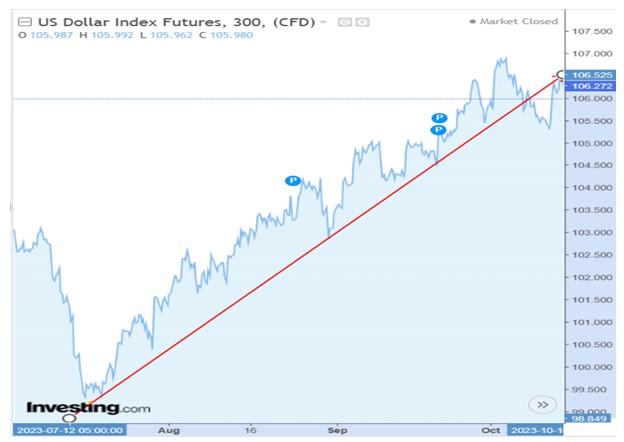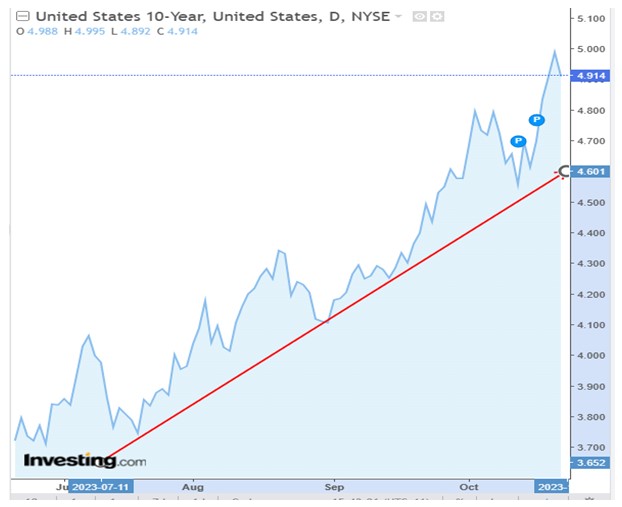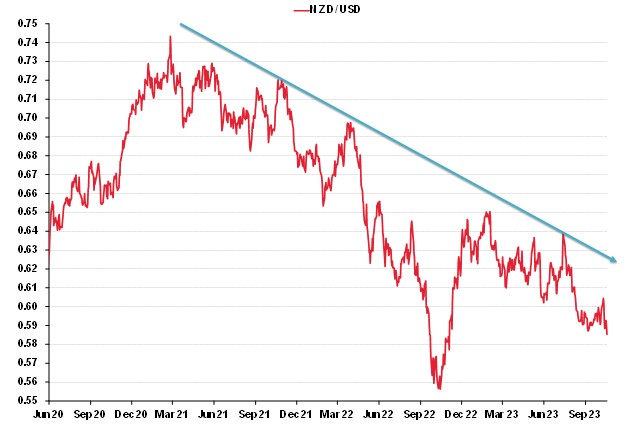
- Is the upward momentum in US bond yields and the US dollar running out of steam?
- Renewed optimism for New Zealand’s economic outlook
The market direction in both the US Treasury Bond yields and the US dollar value has been one of strong upward momentums over the last three months. The US dollar has followed the bond yields higher, resulting in lower NZD and AUD exchange rates against the USD.
Three months ago, the US 10-year bond yield was sitting at 3.75% and not showing any signs of suffering from severe indigestion ahead from the massive increase in US Government issuance of new bonds to fund their whopping budget deficit. The markets and financial market commentators (including this one) seriously underestimated the total lack of investor demand to buy bonds to match that increased supply. The result has been a total rout in the US bond market with yields spiraling up to levels not seen since 2007. Bond supply has well exceeded demand, resulting in the bond prices going down (yields up).
The US does not have sufficient domestic savings to fund their own Government debt, they have always relied on foreign investors buying and holding up to 30% of their bonds on issue. The problem over recent months is that the foreign investors have been very conspicuous by their absence from the market. The Japanese, Chinese and Europeans are the largest owners of US Treasury Bonds, however over the last 12 months the level of foreign ownership has fallen away from nearly 30% to 24%.
The Chinese are most likely large sellers (not buyers) of US bonds at this time as they reduce their foreign reserves and bring funds home to shore up the Yuan’s exchange rate value.
The Japanese and European investors are not buying, as their clearly see the US dollar as overvalued against their home currencies and therefore it is not a good exchange rate entry point to be buying USD investment assets. The risk is too large of incurring FX losses when the USD ultimately depreciates. They will wait and come back as investors when the US dollar is lower in value – a better entry point.
The situation in the US Treasury Bond market tells you that the US dollar is overvalued, and the US will eventually realise that they need a lower currency value to attract in foreign investors to fund their deficits. Otherwise, their interest rates will continue to go higher and therefore excessively tighten monetary conditions in the US economy and cause a nasty recession.
It is a very high stakes game that the US are playing, the end result is that the rising interest rates is no longer enough to attract funds into the USD, as the risk of economic recession grows. The question therefore remains as; “will 5.00% 10-year bond yields be sufficiently high enough to attract new investors from different domestic sources to match the issuance volumes?” Time will tell, however with US inflation headed to 2.00% next year, one would think that a lot of money will be attracted into bonds as an investment at 5.00%.
The strong upward momentum, to date, in the USD Dixy Currency Index and the US 10-year bond yields over the last three months is depicted in the charts below. It does appear that the rally higher in the USD Currency Index is running out of puff with fresh/new buyers of the USD maybe thinking twice about adding to their existing trading/speculative positions at this elevated level. The USD Index is now back at 106.00 after peaking at 107.00 three weeks ago. It has broken below its three-month uptrend line and is more likely to move lower if upcoming US economic data (inflation and jobs) prints on the softer side.
There is not yet any confirmation that US bond yields have peaked at 5.00%, the level they reached on Friday 20th October. A decrease in yields to below 4.60% on weaker economic data would break below the three-month uptrend line.


Whilst next Thursday’s (27th October) US GDP growth figures for the September quarter will paint a picture of a robust economy with a +4.00% annualised growth rate, on a forward-looking basis the outlook is not as rosy. Consumer sentiment in the US has turned sharply down again, new home builds have stopped under 8.00% mortgage interest rates and auto-loan defaults are at record high levels. US household finances are under pressure, therefore expectations of a soft landing for the US economy may be changing yet again. PCE inflation data the next day should confirm another low +0.20% monthly increase for September, reducing the annual core inflation rate to 3.20%. Federal Reserve members are now less worried about inflation spiralling up again and are finally admitting that they “have done enough” with monetary tightening.
Renewed optimism for New Zealand’s economic outlook
Contrary to the doomsayers’ confident forecasts that the New Zealand economy would fall into a hole this year, we truck on rather well in a changeable and unpredictable global environment. GDP growth for the June quarter exceeded all forecasts at +0.90% and inflation was not as bad in the September quarter as most feared.
The reasons for some cautious optimism for a solid economic recovery in 2024 are many-fold: -
- Business confidence is already rising with a new government that will live within their means and cut the regulatory burden. Increase business investment will only be partially hindered by the high interest rates (relative to recent years).
- The Chinese economy has not imploded with GDP, retail sales and industrial production data all stronger than forecast in September. Dairy export commodity prices have recovered strongly over recent weeks as Chinese demand returns.
- Badly needed major infrastructure projects will get started with the new National/ACT Government inviting in offshore investment partners to make them happen. Every country in the world does ‘BOOT-type” (Build, Own, Operate, Transfer) infrastructure projects and they are positive for the economy provided they are well controlled.
- Strong government leadership, who understand how important a growing economy is to everyone, is expected to move us on from the inward-looking negativity of recent years.
- The recent blow outs in both the external Current Account deficit and internal Government budget/fiscal deficit appear to have both turned the corner and are now reducing. The credit rating agencies will relax as the downgrade risk reduces.
- Strong immigration is still needed to address the many worker shortages. Whilst the increased numbers adds to pressure on housing, hopefully the various regulatory restrictions on new house-builds will be changed and activity levels increase.
- A rejuvenated All Blacks team winning the Rugby World Cup next week would also lift the mood of the nation to something a lot more positive.
New Zealand can get its “mojo” back with a new Government adopting a fresh approach that encourages business investment and expansion.
The NZ dollar has been under downward pressure from a strong US dollar and a weaker Chinese Yuan for 2 ½ years now. It will need a reversal in rising US bond yields to turn the USD into a downward trend. When that happens, the NZD/USD exchange rate will have a better than even chance of breaking up through the downtrend line at 0.6150.

Daily exchange rates
Select chart tabs
*Roger J Kerr is Executive Chairman of Barrington Treasury Services NZ Limited. He has written commentaries on the NZ dollar since 1981.
11 Comments
Given historical pricing of the NZD/USD cross - around current levels should be massive support for the Kiwi - it's very few, short lived and far between when historically the cross sits at present levels.
Given that if US Bonds and geo political issues continue to perculate - do wonder when/if if you would see a stampede for the door if NZD continues to decline.
Very brave man/woman selling into the NZD at these levels given risk/rewards profile but guess if you are brave it might pay-off.
Think Oz inflation figures are out on Wednesday and given lack of NZ data (Stats NZ plain terrible) - might give an insight into future direction of RBNZ given correlation between Oz/NZ and accordingly see continued selling or potentially very decent rally.
I detect a little too much optimism in what the new Gvmt might be able to deliver. Barring new reforms (which we have no money for) the old reforms are still clogging the galleys and new problems demanding lots of cash (stimulatory presumably) have hardly gone away. If business sentiment alone could fix a systemically troubled economy then we aught just write a bunch of happy pill scripts and dance our way to economic nirvana.
There’s more iceberg under the surface than this article gives credit to. Not least that very influential seats of power (Auckland and Wellington central) and their attendant bureaucrats (both won by greens) seem hellbent on being a non-agricultural nation, and also a non-mining nation, non-forestry, non-industrial and non- almost everything else. So how we plan on getting the ship steaming again without firing the cylinders of any of these things (and their environmentally vulnerable bits) remains to be seen. Without an actual plan - we default into whatever makes money on the day - and then spend the next decade complaining about how that thing ruined NZ, before heralding labour and the greens back into power to sooth our conscience - starting the mess all over again. Confidence is one thing - a plan is something else and I’ve yet to see either - but I’m hopeful for both because I guess you have to be.
Terrible analysis as usual from Roger. No recession but can't bring himself to credit Labour in any way.
It will be interesting if the NZ dollar doesn't go stratospheric, how will Roger justify that given National and Act are now in? I'm looking forward to him squirming to fit the data to his already decided narrative.




We welcome your comments below. If you are not already registered, please register to comment.
Remember we welcome robust, respectful and insightful debate. We don't welcome abusive or defamatory comments and will de-register those repeatedly making such comments. Our current comment policy is here.